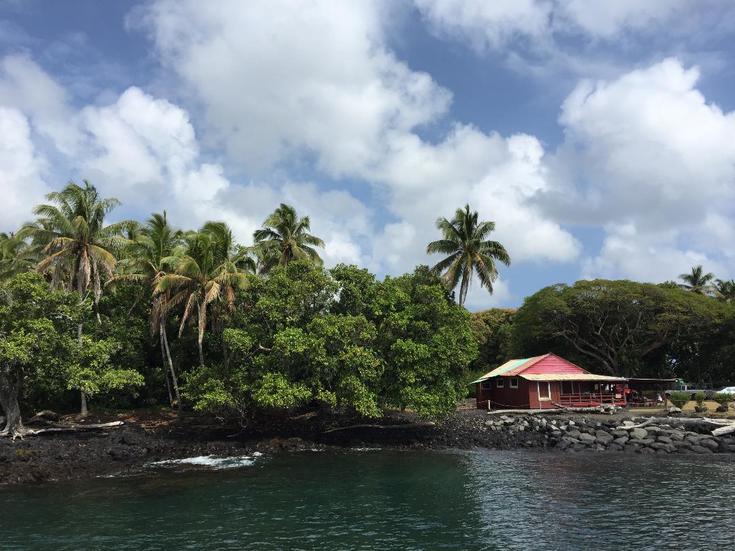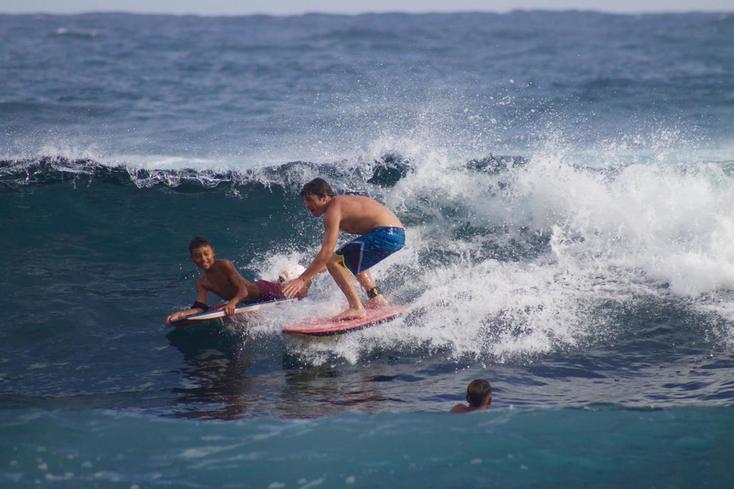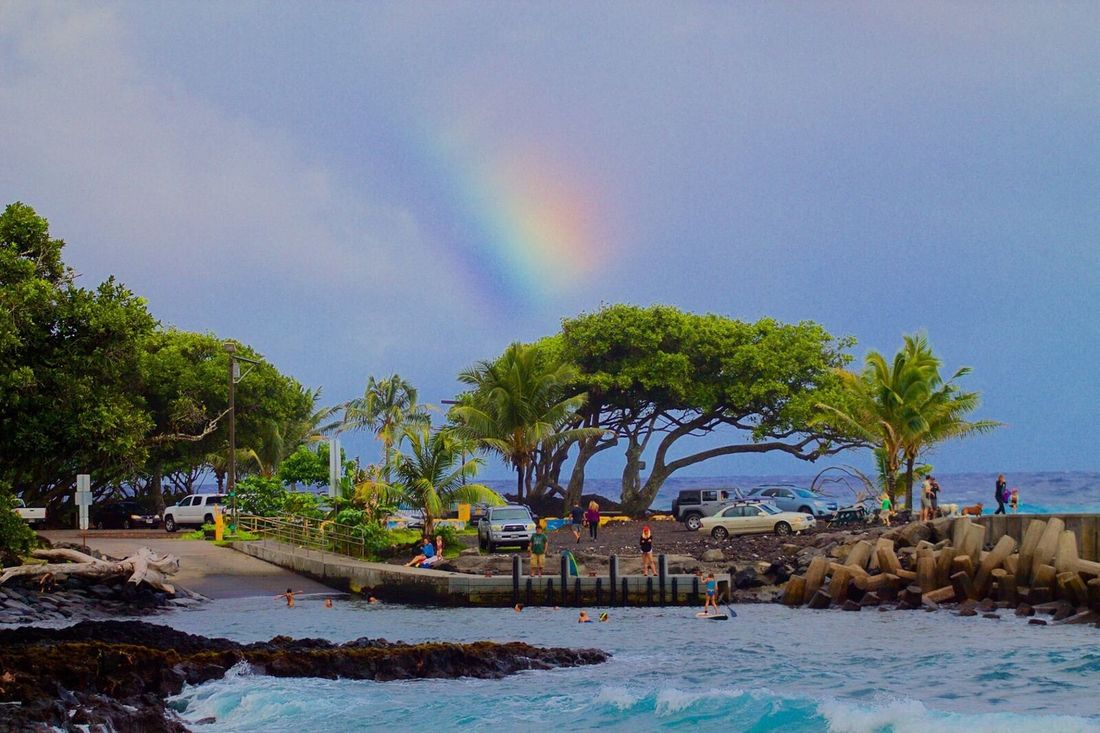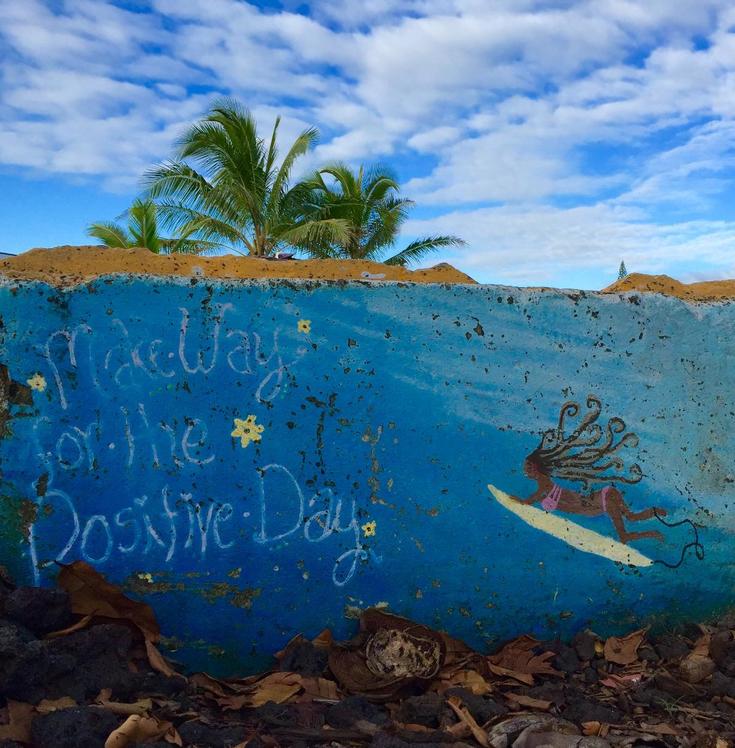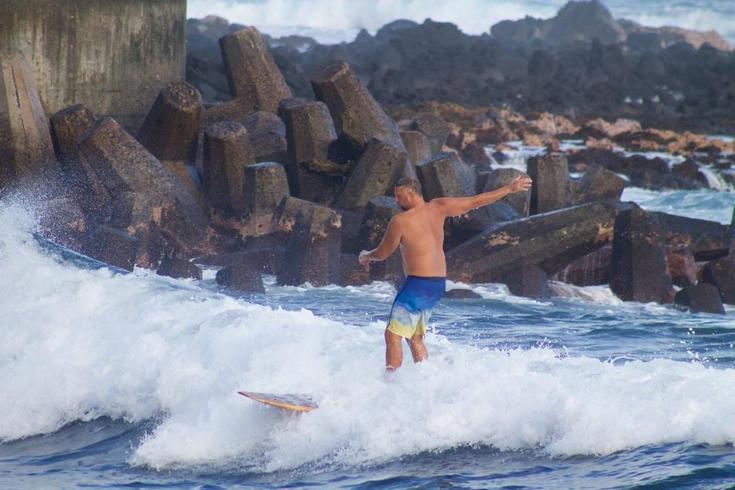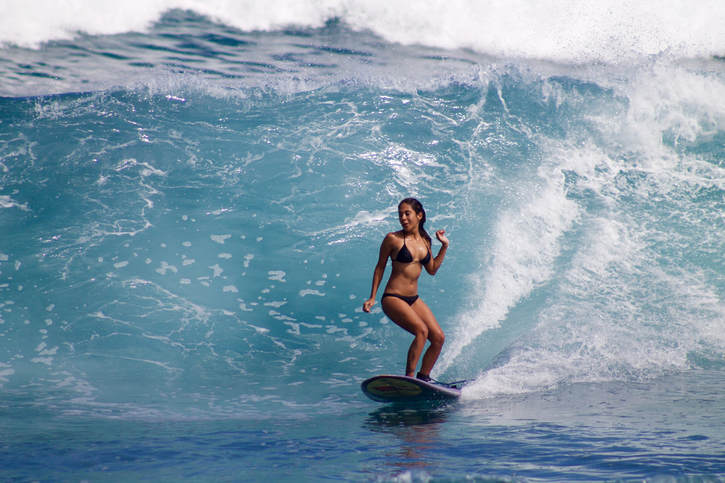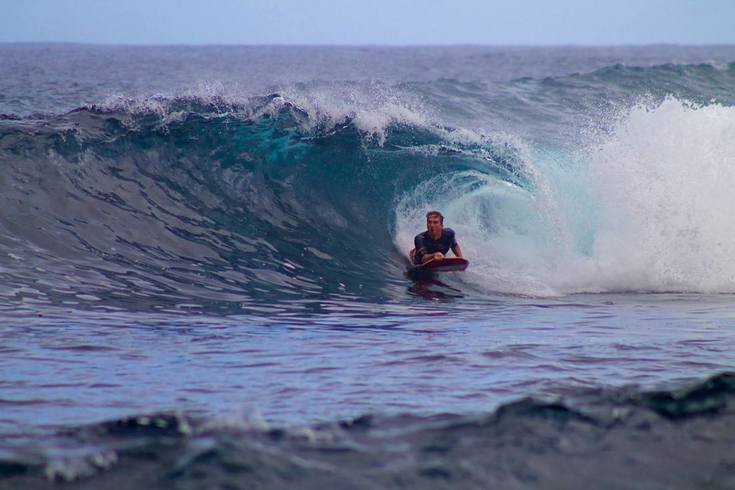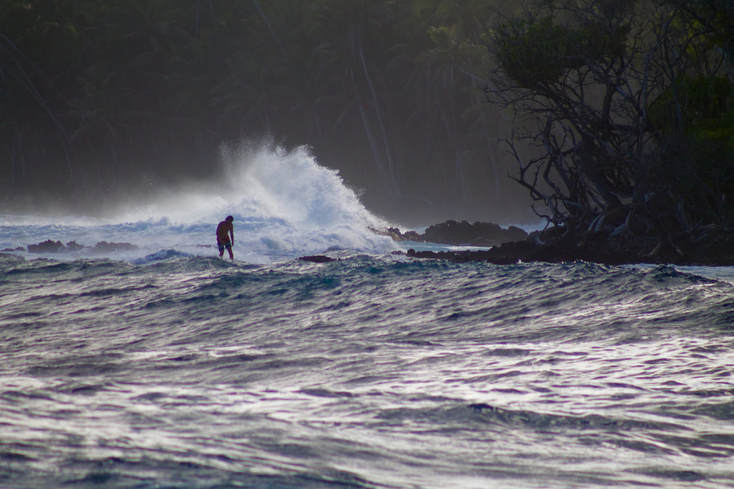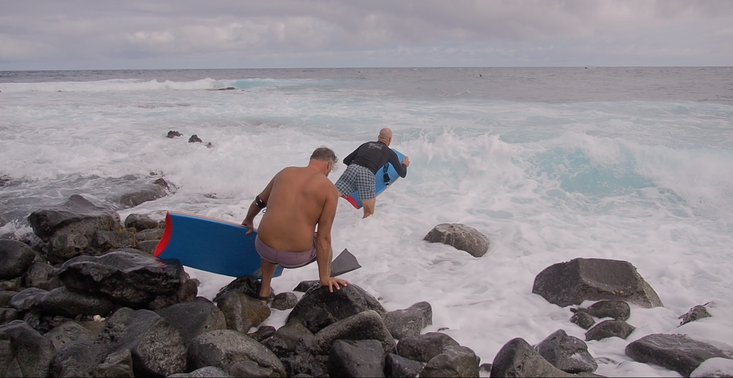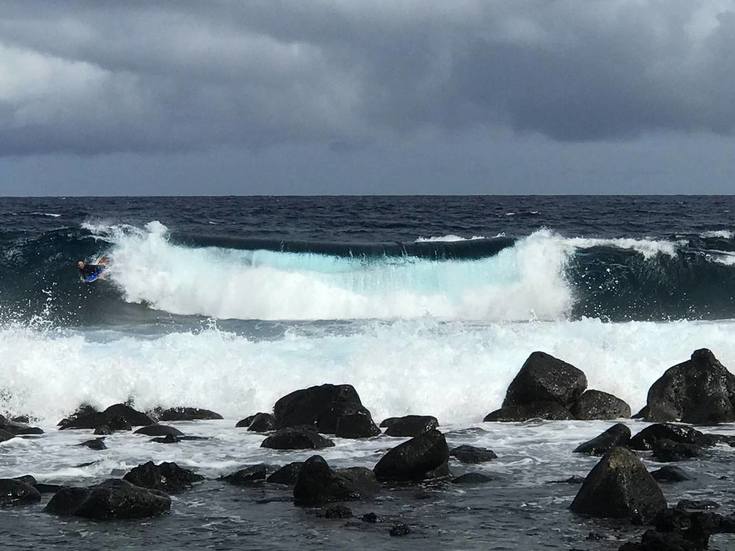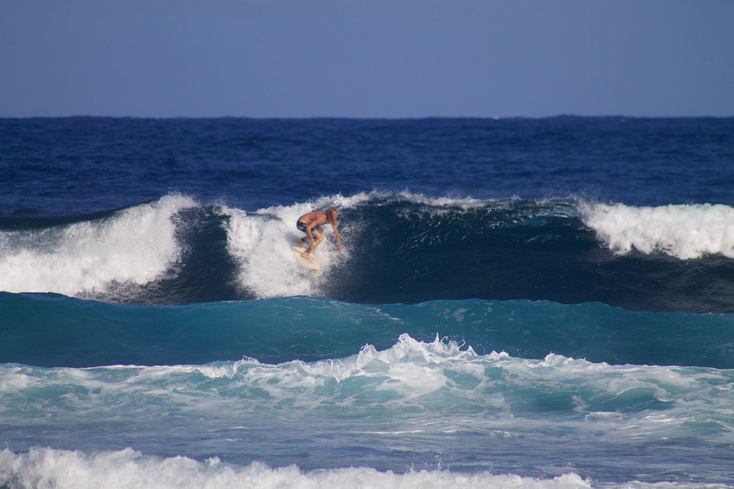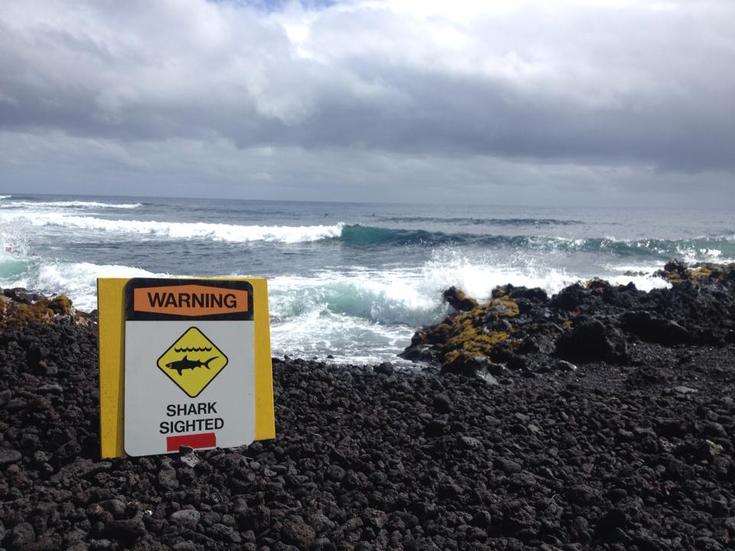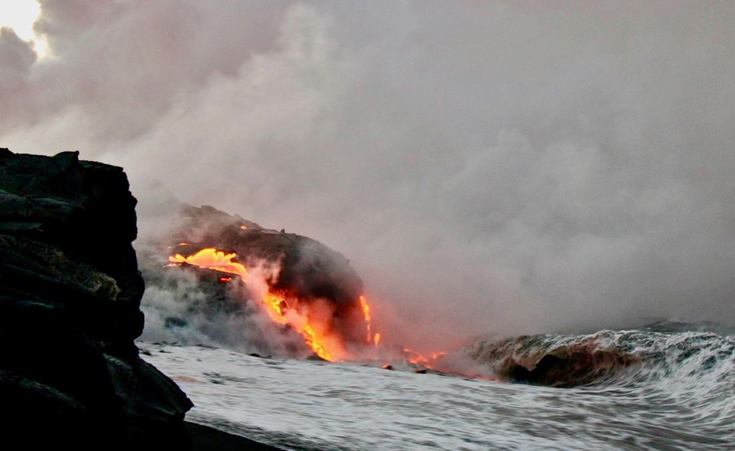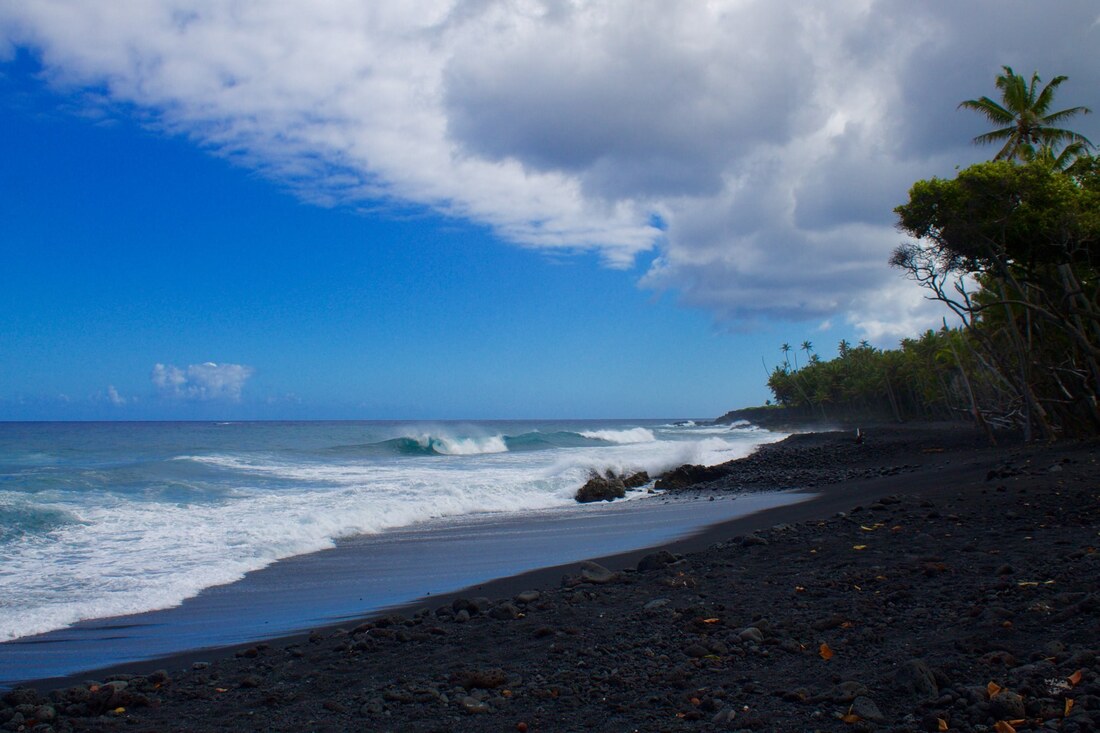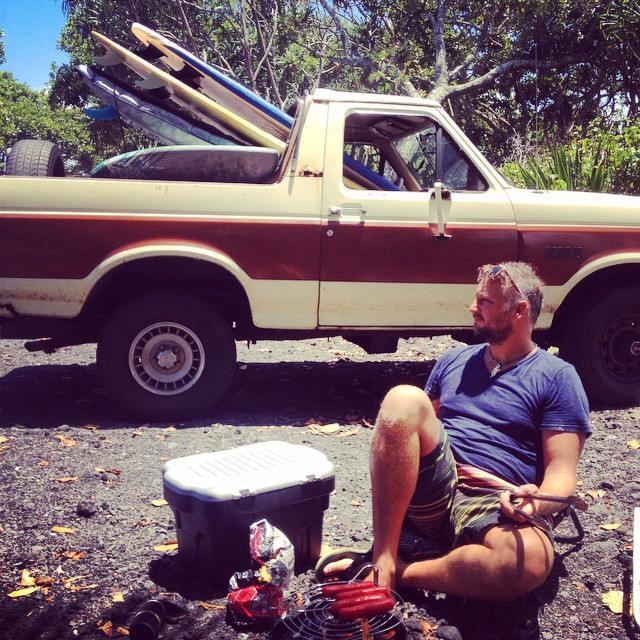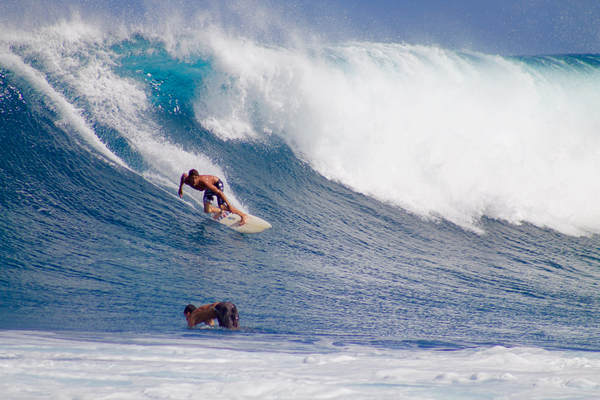 Surfer on a gorgeous wave at Pohoiki. Photo Credit: Rod Miller
Surfer on a gorgeous wave at Pohoiki. Photo Credit: Rod Miller Sunday: As I write this I’m above the Pacific, flying back to Hawai'i where the Kīlauea Volcano is erupting, making my partner and I, as well as many others, lava refugees for the last three months. Currently, lava is .75 miles away from overtaking and covering one of the greatest surf breaks in Hawai'i. A spot I know well.
A Truly Great Hawaiian Surfing Break
The prospective loss of this little known Big Island spot is one that really stings for people that have basked in the glow and magic of this place. The spot I’m referring to is called Pohoiki aka Isaac Hale Park. Pohoiki lies on the Eastern Coast of the Big Island in a District called Puna. It is one of a very small handful of surf breaks on the East Coast of the Big Island and I submit it is one of the greatest breaks in the Hawaiian Islands.
Now when I use the word 'greatest' I don’t mean Pohoiki has the largest waves, although I’ve witnessed people drop in on 20+ footers there. I don’t mean that Pohoiki is the most well-known spot like Peahi (Jaws), Waikiki, or Pipeline. I don’t mean that it is the greatest because it was often mentioned in Surfer Magazine or any major surf publication. I mean it is a great surf spot because the waves are very consistent, it is often uncrowded, naturally beautiful, and has one of the best and diverse groups of regulars of any surf break. It offers a lot of different surfing skill options all in one place.
Pohoiki is also more than just a surf spot. It is an important community meeting place where locals, both Hawaiian and haole, as well as, a trickle of adventurous tourists interact, generally harmoniously. On any given day Pohoiki is a confluence of surfers, fisherman launching their boats, families with their children swimming at the boat ramp, snorkelers, locals grilling or selling food, and sometimes having unofficial drag races. It's people hanging out and basking in the glow of a place where the ocean meets the land in a way that offers something for everyone.
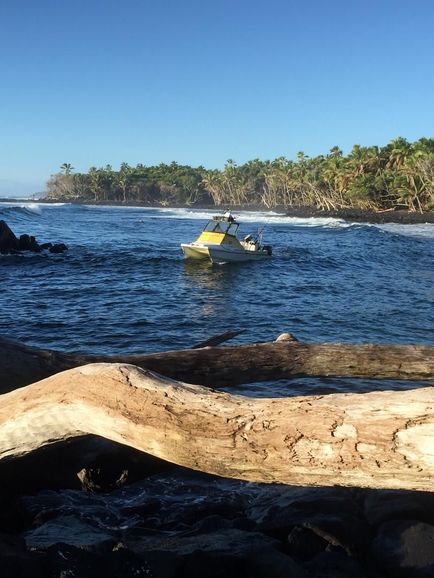 A fishing boat pulls into the boat ramp. Photo Credit: Tim Schirmang
A fishing boat pulls into the boat ramp. Photo Credit: Tim Schirmang A Port in Puna
Pohoiki means 'two little moons'. In 1963, The Army Corps of Engineers carved out a channel with a jetty in a 1000 foot bay that contained two half moon bays with a reef in the middle. They built a boat ramp and in doing so created the only port and safe ocean access area in this rugged and untamed part of Hawai’i. It allowed access for fisherman to this rarely fished part of Hawai’i and a safer place for locals to enter the water to swim and surf.
Puna is definitely one of the most unique areas in Hawai’i because it is located on the face of the most active volcano in the world, Kīlauea. As was revealed many times in the last century, the volcano can retake the land from the residents here at any time. The result is an area low in large scale development from hotels and resorts (expensive properties can’t be insured) which has kept the land cheap and the cost of living low. This has allowed people who didn’t have much money to live here, including Native Hawaiians, hippies, mainland dropouts, and adventurous travelers looking for less crowds and a less commercial, more authentic Hawaiian experience. Pohoiki is a place where a lot of those people come together and commune with the sea.
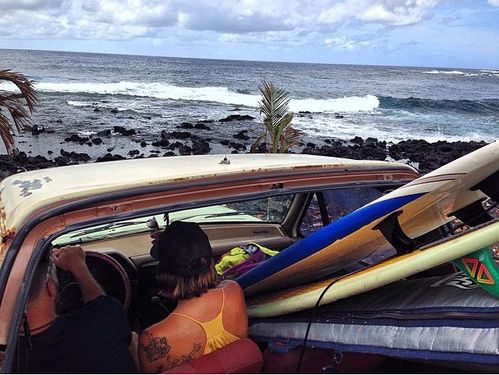 Checking the waves at First Bay. Photo Credit: Louis Amberg
Checking the waves at First Bay. Photo Credit: Louis Amberg First, Second, and Third Bay
The Bays are known by the not so original names of First, Second, and the lesser known Third bay. They offer distinctly different types of waves on different conditions. On smaller days, First Bay, a right hander, is an ideal place for beginners and keikis (children) to catch gentle waves that end on a shallow but very forgiving reef. There is a spot very close to the middle reef that is pretty much exclusive for bodyboarders as it is to steep and shallow for surfers. This allows some bodyboarders to have their own spot, almost right on the middle reef, usually separate from surfers.
On medium sized and bigger days at First Bay a surfer can catch a great wave just outside the middle reef and ride a beautifully formed right across the deeper channel almost all the way into the boat ramp where the wave gently deposits you. The crystal clear water allows for amazing visuals of the reef below. This is the wave I learned on in 1998 when I first came to Puna. On weekdays back then it was often just myself and an older local Hawaiian surfer. I would sit and study him as he knew exactly where to take off and how to trim himself into this beautifully formed wave. I remember the intensity in his eyes as he caught wave after wave. In between his rides I would sheepishly paddle into his takeoff spot and try to get one for myself. After many failed attempts, one day I did and it was pure bliss!
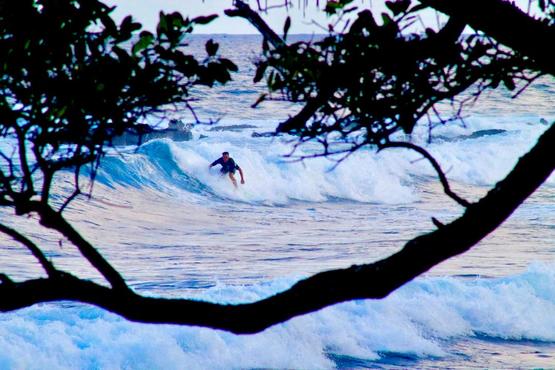 A through the trees look at a regular on the inside right at Second Bay. Photo Credit: Rod Miller
A through the trees look at a regular on the inside right at Second Bay. Photo Credit: Rod Miller
Once you learned to surf the wave inside and not put your feet down all is well at Second Bay. This break has a steady stream of regulars which include in the morning a dawnish 6 a.m. crowd, the 7:30s, and 9:00s. I chose to go out at 11 a.m. and sometimes I’d be the only one out. On big days the wave breaks on an outside reef and connects to several sections leading to the inside wave. Myself and many surfers have reveled in this wave, as well as, the scenery which includes many honus (sea turtles) lazily swimming around, and a gorgeous landscape of lush jungle set against a backdrop of rugged lava. And there is almost always waves at Second Bay.
Many surfers, including myself, reveled in this wave as well as the scenery which included many honus (sea turtles) lazily swimming around, and a gorgeous landscape of lush jungle set against against a backdrop of rugged lava.
Another place you didn’t want to end up was on the reef between the two bays. Many Pohoiki surfers, especially beginners, ended up high and dry on there. Once there the ocean comes in and unforgivably knocks you down as the the sharp reef slices through your skin with ease. Just like Second Bay, once you got to know the shifting currents and spots you could easily navigate around the reef, surf right up to, or even over it in the right conditions.
Further out the channel from First Bay and to the left is a spot called Dead Trees or ‘Deadies’ for short - because of the dead trees that stubbornly remain directly in front of the peak. (I always love how unromantic and practical surf spots are named). It is basically a reef slab going from very deep to shallow forming a gorgeous, steep, fast, hollow wave which can be ridden left or right. Also, high consequences if you don't negotiate the reef correctly. I had never rode this wave until bodyboarder/surfer Mike Stewart took me out and explained the wave to me and why it was his favorite wave on the Big Island.
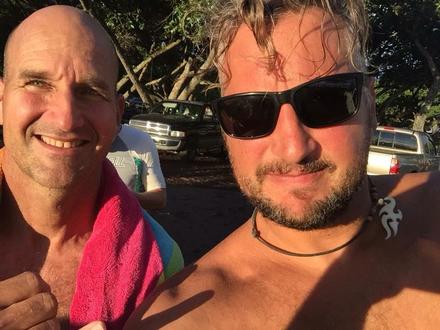 The first time meeting Mike Stewart at Pohoiki.
The first time meeting Mike Stewart at Pohoiki. Meeting and Surfing with a Legend at Pohoiki
One day after surfing a big swell at First Bay I was exiting the water and a local Hawaiian guy yelled out, “Hey Mike Stewart.” I thought, “Does he mean 'THE' Mike Stewart?” I turned around and sure enough right behind me on the boat ramp was the Bodyboarding/body surfing World Champion himself. Now I am keenly aware of who Mike Stewart is because I started my wave riding career, like many people, as a bodyboarder. I only learned how to stand up surf at Pohoiki many years later. In the late 80's and early 90's when bodyboarding was developing as a viable surfing sport, Mike Stewart was the man. A blond haired blue eyed Hawaiian born guy who became the best known bodyboarder in the world. I had pictures of Mike on my wall in huge barrels at Pipeline when I was a teenager. Mike has developed a well-deserved reputation and respect from even stand up surfers as a true waterman, diplomat, and surfing pioneer.
Here I was 30 years later surfing at my home break in the same place as one of my childhood heroes. It took me a while to work up the nerve to go up to him, but when I did I learned that Pohoiki was one of his favorite breaks and that he was in fact a full time, long term, Big Island resident. I told him I lived in Kalapana, surfed Pohoiki often, and that I had a cooking / travel TV show. I shyly suggested he should be on the show someday.
Subscribe to the
CETV Youtube Channel for more Hawai'i Food Adventures
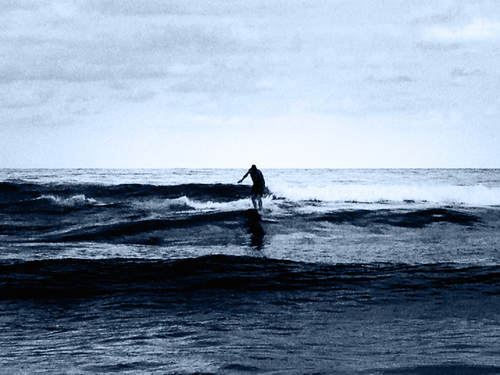 The author on a long one at Shacks Photo Credit: Bailey Ferguson
The author on a long one at Shacks Photo Credit: Bailey Ferguson Secrets, Shacks and Bowls
Now as if the Bays aren’t enough for one spot to offer there is a whole different world just a short walk through the parking lot to the North side of the park and beyond. Strangely at the end of another Bay there is a lifeguard stand. Yes, there are lifeguards at this County Park in this remote part of Hawai'i and I am always glad they are around. They are also some of the best surfers at Pohoiki. This bay has two major breaks known as Shacks (as in in front of the lifeguard shack) and Bowls. The entry spot for both breaks is a small rocky pool not far from the lifeguard stand. The entry and exit is much easier than it looked and I believe to this day that has kept many surfers away from these amazing waves. Further North there is another shallow break known as Secrets which many surfers insist is the best wave on the island.
As you go South, closer to the lifeguard shack, there are two more peaks that collectively made up Shacks. These waves break deep and fat. They form and break into a deeper spot so they aren’t as steep and pitchy as bowls. This makes it a great spot for longboarders who can catch the wave way outside and go left or right or both on the same ride. That’s what I love about Shacks. You can change direction as the wave would reform twice before you run out of room.
Surfing in Hawai’i always means the possibility of an encounter with a shark. In 2013, a local 16- year-old surfer was attacked by a shark as he was surfing at Dead Trees. He’s definitely lucky to be alive but ended up with 30 lacerations to his legs and hips requiring 180 stitches. People were a bit spooked at Pohoiki, but that wore off quickly. Several times I would go to paddle out and see the big yellow “Shark Sighted” sign set up in front of the break. I would go talk to the lifeguard who would tell me a shark chased people out of the lineup yesterday or that he saw a monster hammerhead swimming by just outside the break at Bowls. Sometimes I would still go in the water and sometimes I wouldn’t. I also heard a story from a guy about a large Tiger Shark chasing him out of Second Bay as people stood on the beach and watched as the shark got within one foot of the guy before giving up chase. Luckily for me I never saw a shark at Pohoiki, but everyone knows they are around.
Subscribe to our
CETV Youtube Channel for more Hawai'i Food Adventures
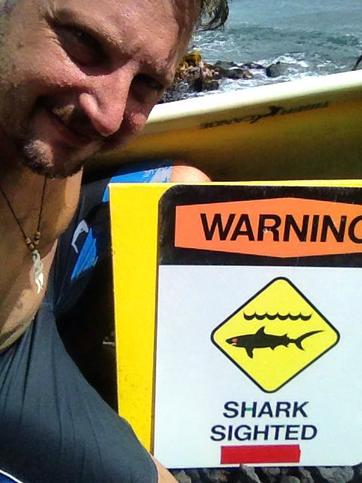 The waves are to good to be deterred.
The waves are to good to be deterred. 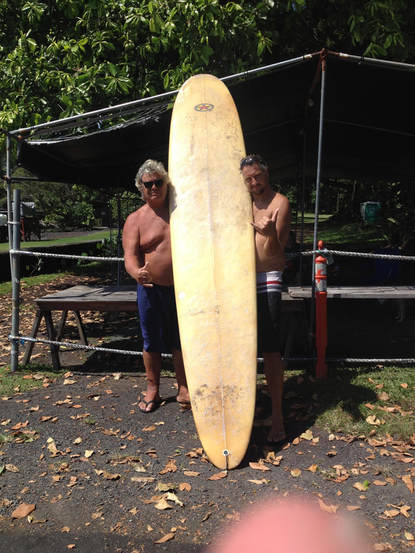 With shaper Gerry Grantham and the board that snapped in half at Second Bay.
With shaper Gerry Grantham and the board that snapped in half at Second Bay. 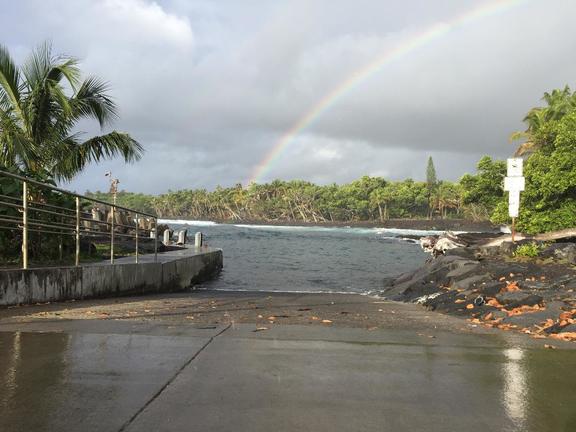 A warm and inviting ocean entry. Photo Credit: Tim Schirmang
A warm and inviting ocean entry. Photo Credit: Tim Schirmang Geothermal Warmth and A Natural Hot Tub in the Jungle
One of the greatest things about surfing at Pohoiki is entering the water at the boat ramp which has geothermal vents that shoot out into the boat ramp area. The water is always as warm as a bath going in and coming out. A far cry from my freezing water entries in Northern California. Probably one of the best features of Pohoiki is a short walk down a path, past an iconic red, Hawaiian-style house, into the jungle and you come to a geothermal pond. An oasis of clear water that is partly fed by the ocean like a tide pool and partly fed by fresh water from geothermal vents that heat the pool to about 90 degrees. It is never that crowded and many times after a session I would head over there for an amazing soak and lose myself looking up at the coconut palms and dense jungle foliage canopy. Totally epic. I couldn’t even make a feature like this up for a surf break.
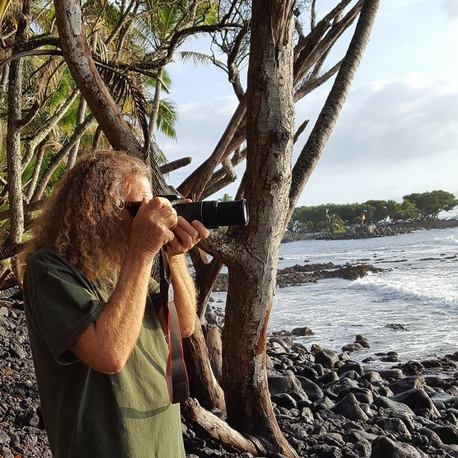 Local photographer captures the surfing action for his Facebook page featuring Pohoiki
Local photographer captures the surfing action for his Facebook page featuring Pohoiki One of the worst things about surfing in this modern era is the crowds in the break and the bad attitude that that can foster in a lineup. On a day with a good swell at Ocean Beach in San Francisco you can see a hundred people in black wetsuits bobbing up and down in one stretch of beach. At Pohoiki, I would always marvel at how good the waves were, compared to the amount of people in the water. And for the most part, besides some minor, isolated skirmishes, there is very little attitude or localism displayed by anyone in the break. No attitude, no drama, no bullshit. This is my home break. You learn the meaning of Aloha from experiencing Hawai'i at a place like Pohoiki.
Pohoiki recently was lucky to have our own photographer. Puna local Rod Miller started coming to the break five years ago and taking shots of the surfing action at this spot. "I like taking photos, and the action of surf photography makes it the most fun. Pohoiki has great breaks and access from many points of view. Also I can get a bit closer to the surfers because of the bay contour and breakwater pier. It's a beautiful place, and the water is always clean and clear," Miller said. Rod posts his daily shots on his Facebook site Pohiki Kine, so a lucky surfer can get a great wave and later see it captured beautifully in a photo.
Lessons in Impermanence
This is not the first time Puna lost a great surf spot to the volcano. In 1990, Kīlauea erupted covering two towns called Kalapana and Kaimu, 9 miles South of Pohoiki. The eruption filled in a Bay with lava that used to be one of the best surf spots on the island. I’ve talked with surfers who were dedicated to those spots known as Kaimu Bay and Drainpipes. One local long boarder told me she and others locals were surfing the spot for the last time as they watched the lava coming down the mountain and filling in the bay. It is an unusual thing to lose a beloved surf spot. Now it has happened twice here in Puna in only the last thirty years.
Myself and many others, are being forced to truly come to terms with the continuing transient nature that is the norm of the universe that we occupy. Losing Pohoiki, as I knew it, is indeed a huge loss for myself and the lower Puna area. Most Buddhists believe, “all temporal things, whether material or mental, are compounded objects in a continuous change of condition, subject to decline and destruction." And from this destruction comes creation. Maybe some new breaks will develop where the lava has moved in. Rumor has it that the lava has deposited black sand in front of Shacks and Bowls turning a reef break into a beach break! The volcano that created these great islands is in control now.
For now, Mahalo nui Pohoiki. Thanks for everything you provided. I’m humbled and grateful to have experienced this truly remarkable Hawaiian surf spot fully. I will celebrate it’s greatness, talking story about it's beautiful waves, and standing ready to explore any new iteration of this spot that emerges. Respect.
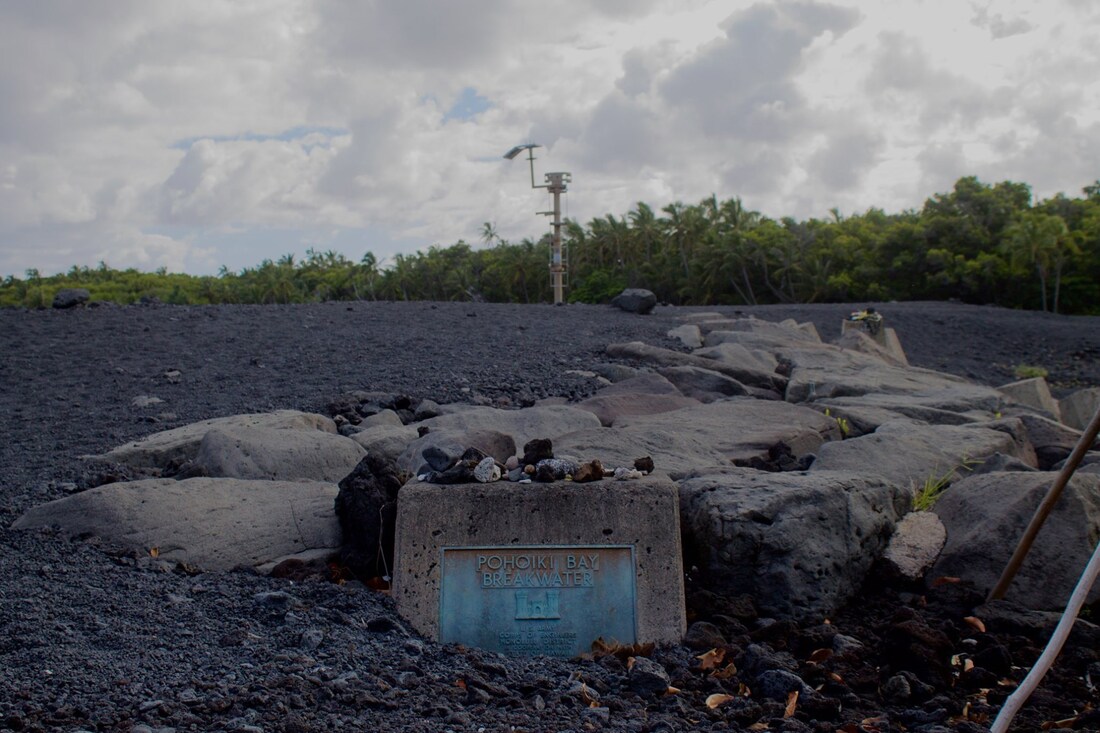 Remnants of the old jetty Photo Credit: Rod Miller
Remnants of the old jetty Photo Credit: Rod Miller 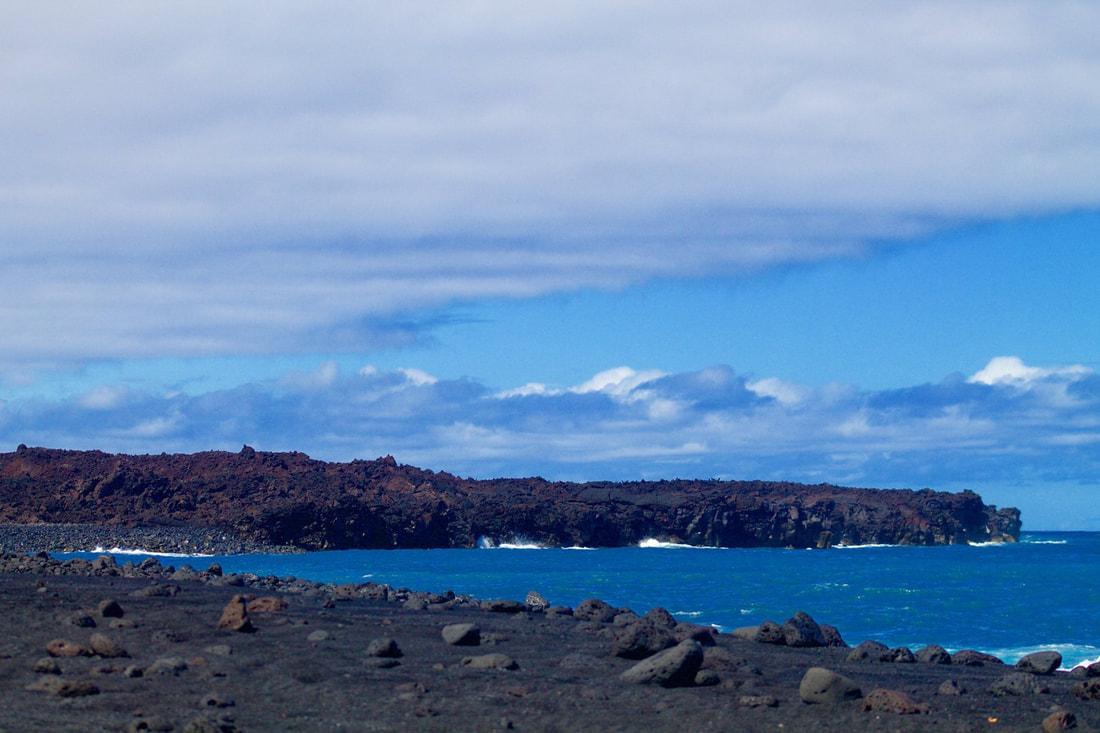 A finger of new land where Dead Trees used to be | Photo Credit Rod Miller
A finger of new land where Dead Trees used to be | Photo Credit Rod Miller This year has been another one of those lessons in impermanence as the global pandemic has altered life as we knew it. Another reminder of how fast things can change in this world.
Since I wrote the above article, my partner and I moved to Kona, on the other side of the island. We live in walkable distance to several surfing breaks, including Banyans, Lymans, and Alakala's.
Sometimes when I'm out surfing over here I'll talk like an old timer about Pohoiki's greatness. Many of the surfers over here never went there, so to them I must sound like some old man pining for an old love. Occasionally I'll see a former Pohoiki regular paddle out over here. That's when the reminiscing starts! Ah the glory days. Aloha ahiahi!
Chef Andrew “Ellard” Resignato was born in Brooklyn, NY and raised on the Jersey Shore. He is a chef, surfer, fisherman, writer, public health advocate, economist, musician, filmmaker, reformed politician, and part-time philosopher. He is currently the Producer and Host of the the food & travel show the Culinary Edge TV. When not traveling the globe in search of good food and waves he resides on the Island of Hawai’i eating good food and riding good waves.

